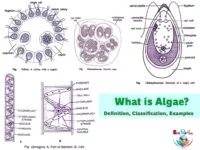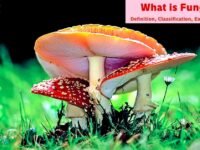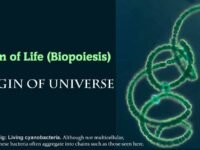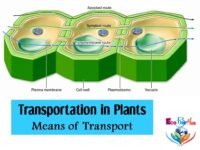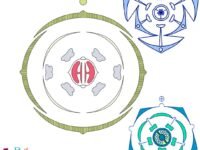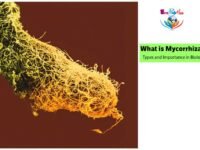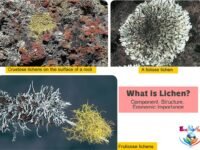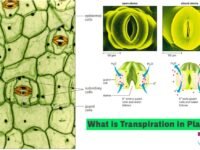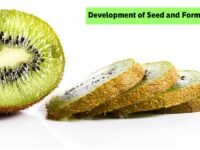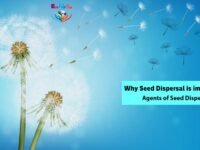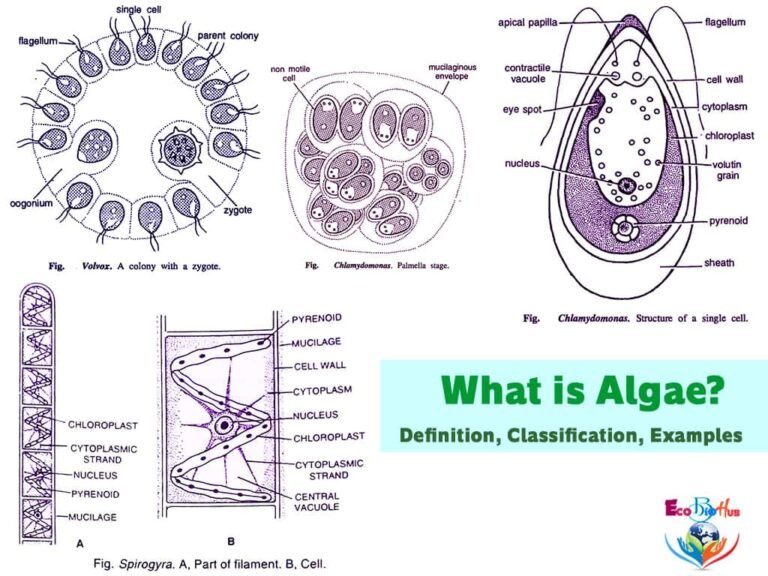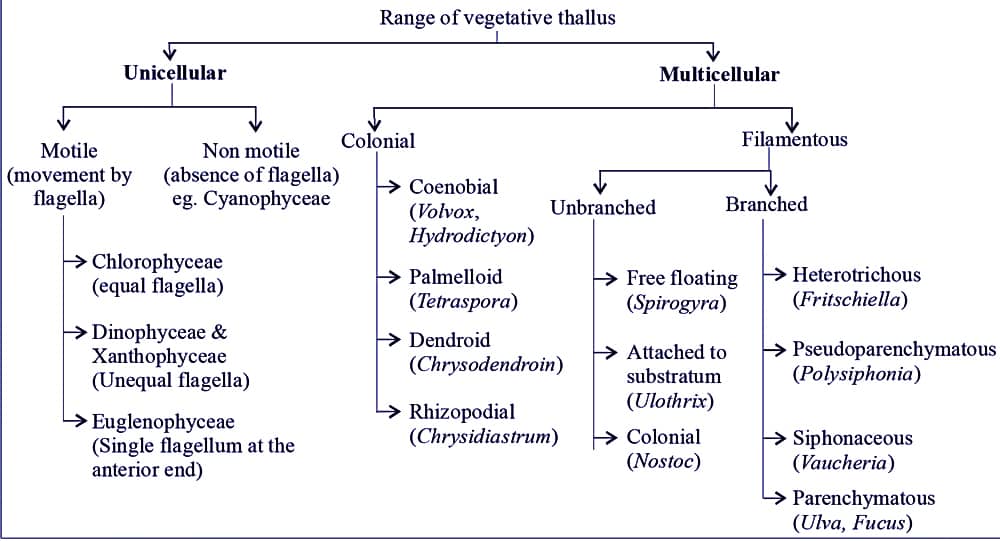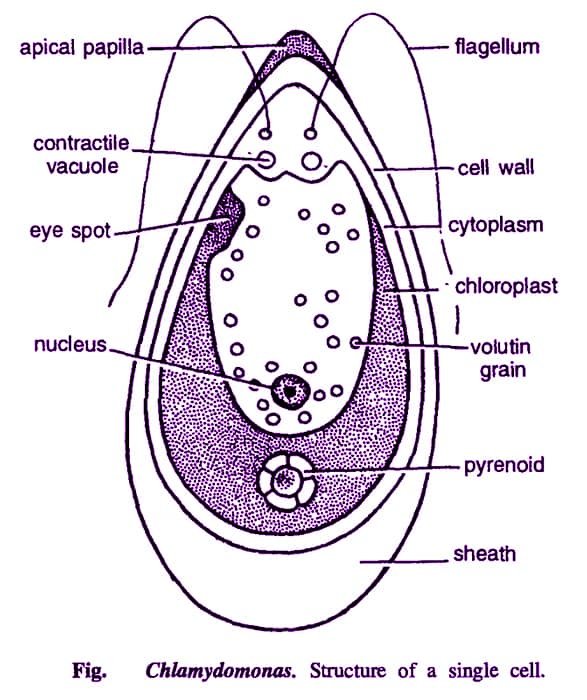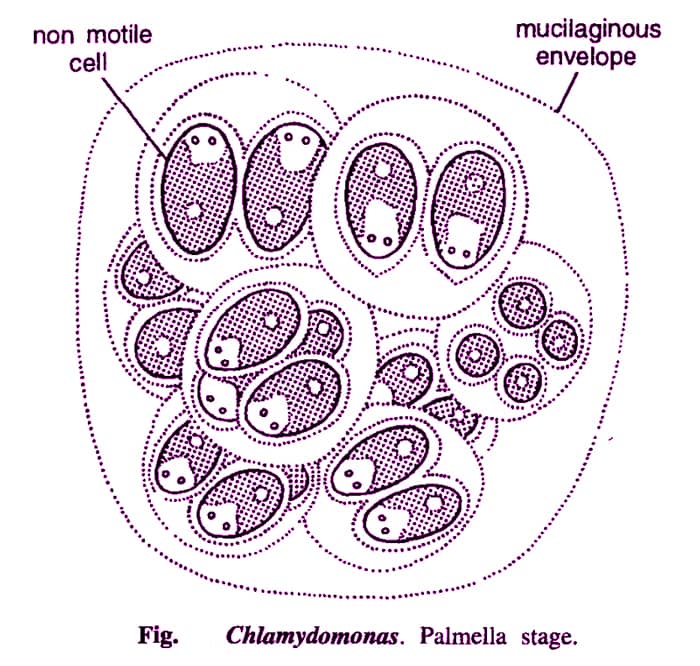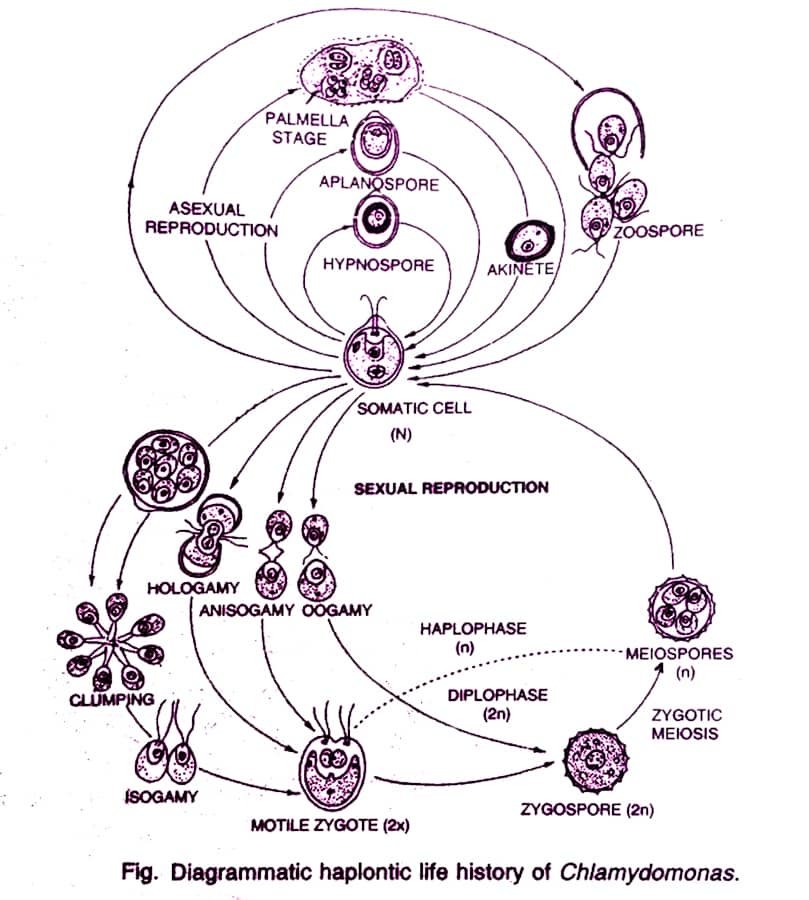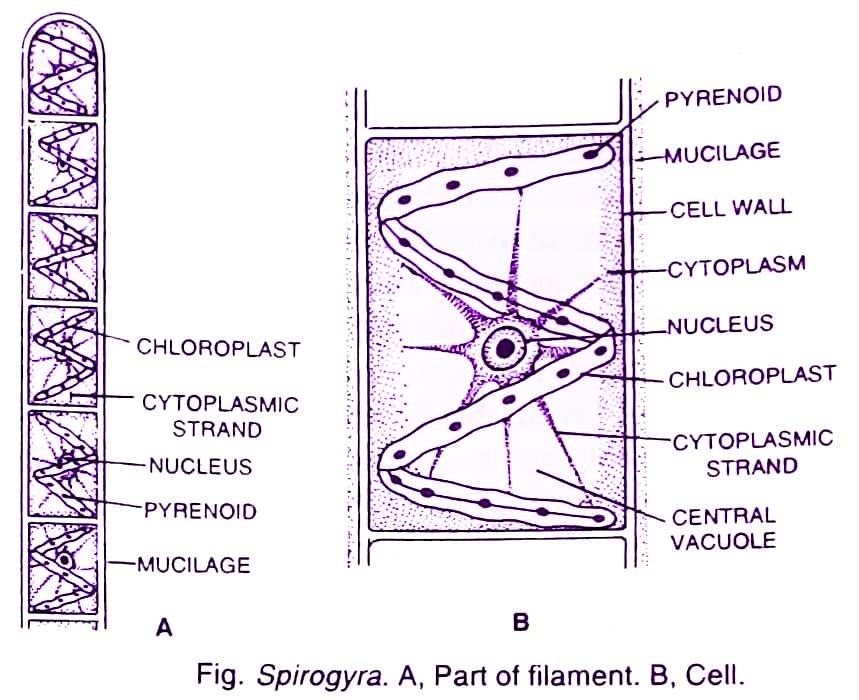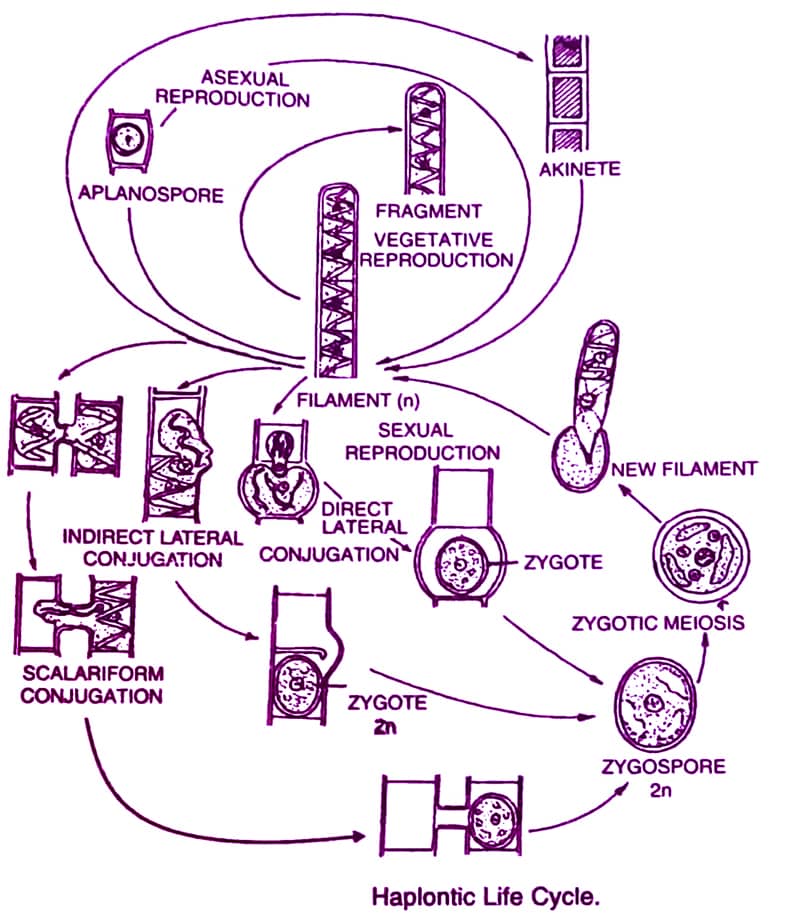In this tutorial, we have defined ‘What is Algae?‘ and explored ‘Classification of fungi‘, ‘Economic Importance of algae’, etc.
Thallophyta (Gk. thallos – undifferentiated, phyton – plant) was first introduced by Endlicher (1836). It comprises the simplest plants which possess undifferentiated or thallus like form, reproductive organs single celled non-jacketed called gametangia; embryo stage, vascular and mechanical tissues are all absent. Differentiation of true roots, stems, and leaves is also absent. Asexual reproduction by accessory spores is very common. Presently, it includes only Algae.
— Algae Definition: Algae (L. Alga – see weed; singular – alga) are defined as eukaryotic, autotrophic (holophytic), chlorophyllous, thalloid, non-vascular plants with no cellular differentiation. These are characterized by the absence of the embryonic stage and the presence of non-jacketed gametangia. Mostly, they are of aquatic habitat (both freshwater and marine).
— A plant body that is not differentiated into a root, stem, and leaf is known as thallus.
— The word ‘algae’ was coined by Linnaeus (1753).
— The branch of botany dealing with the study of algae is called phycology or algology. Term phycology is derived from the Greek word phykos which means ‘alga’ or “sea weed”.
— Algae contains about 18,000 genera and 29,000 species.
— Structure and reproduction of algae were written by Dr. F. E. Fritsch. He is known as Father of Algology. (Prof. MOP Iyengar is regarded as Father of Indian Algology). Fritsch divided algae into 11 classes on the basis of type of pigments, nature of reserve food material and mode of reproduction.
[su_box title=”Famous Algologists in India” style=”noise” box_color=”#731862″]● Ghose (1919) was the pioneer Indian worker who studied algae.
● Prof. M.O.P. Iyenger was a student of Dr. F.E. Fritsch, who started the study of algae in 1920 at Madras University. He is known as the Father of modern algology in India. His important contribution is the discovery of a terrestrial alga called Fritschiella tuberosa.
● In B.H.U., Prof. R.N. Singh was involved his important work is the reclamation of saline user land by growing blue-green algae.
● Prof. H.D. Kumar worked on algae physiology. He also studied genetic recombination in blue-green algae or cyanophyceae or myxophyceae or cyanobacteria.
[/su_box]
► Read More: What is Fungi? Definition, Classification, Examples ► Read More: Angiosperm Plant Families and their Floral Formula ► Read More: What is Mycorrhizae? Types and Importance in Biology ► Read More: What is Lichen? Component, Structure, Economic Importance ► Read More: Origin of Life (Biopoiesis) and Origin of Universe ► Read More: What is Life? Definition & Characteristics of Life ► Read More: Transportation in Plants || Means of Transport
TABLE OF CONTENTS
CLASSIFICATION OF ALGAE (FE Fritsch; 1935)
GENERAL CHARACTERISTICS OF ALGAE
01. Algae are usually aquatic, either marine or fresh water. Only a few algae occur in moist terrestrial habitats like tree trunks, wet rocks, moist soil, etc.
02. Plant body is thallus (a form without any differentiation into root, stem and leaves) which may be unicellular, colonial, filamentous, parenchymatous or pseudoparenchymatous.
03. Algae, like other aquatic plants, are covered over by mucilage. Mucilage protects the algae from epiphytic growth and decaying effect of water. It also prevents desiccation if the algae happen to get exposed on the shores during low tide.
04. Vascular tissues are absent. Being aquatic, water conduction is not required. Some of the giant algae do have a system for conduction of food. The same is not needed in other algae because of their small size and the presence of photosynthetic cells all over the body.
05. A mechanical tissue is absent. The body is flexible. It helps the algae to sway with water tides without being torn.
06. Most of the algae are autotrophic and nutrition is photosynthetic. Grana are absent in chloroplast. Algae contain chlorophyll a, carotenes and xanthophylls. Additional pigments like phycobilins, fucoxanthin occur in specific groups.
07. The shape of chloroplast is variable in different algae. These are cup shaped in Volvox, girdle shaped in Ulothrix, ribbon shaped in Spirogyra, reticulate in Oedogonium and stillate in Zygnema.
08. The cell wall is usually made up of cellulose.
09. The reserve food material is in the form of starch mainly.
10. Dominant plant phase in algae is gametophyte. Sporophytic and gametophytic stages are independent.
11. All kinds of reproduction vegetative, asexual and sexual reproduction are found in algae. but vegetative and asexual modes of reproduction are abundant.
Vegetative reproduction occurs through fragmentation (e.g., Fucus, Chara, etc.) and fission, hormogonia (e.g., Oscillatoria, Nostoc, etc), tubers, buds, etc.
Asexual reproduction occurs in favourable conditions. In this process, some cells form motile or non-motile spores. After release, these spores give rise to new plants. Following spores are involved
(i) By zoospore, e.g., Ulothrix, Oedogonium, etc.
(ii) By aplanospore, e.g., Chlorella, etc.
(iii) By hypnospore, e.g., Vaucheria, etc.
(iv) By palmella stage, e.g., Chlamydomonas, Ulothrix, etc.
(v) By endospore, e.g., Anabaena, Nostoc, etc.
(vi) By akinete, e.g., Chara, Oedogonium, etc.
12. Under unfavourable conditions algae reproduce sexually. Sexual reproduction is absent in blue-green algae. In others, it is present. Sex organs are nonjacketed and one celled called gametangia.
13. Water is a suitable medium for the fusion of gametes during sexual reproduction.
14. Fusion of male and female gametes occurs and the zygote is formed. An embryo stage is absent.
15. Life cycle is various— haplontic, diplontic or diplohaplontic.
Algae are usually differentiated on the basis of their pigments, flagellation and storage Products (in below Table). Algae included under Kingdom Plantae by Whittaker (1969) are of three types— red algae, brown algae, and green algae.
Table: Differences amongst red, brown and green algae
| Red algae | Brown algae | Green algae |
| Mostly marine. | Mostly marine. | Mostly fresh water and subaerial. |
| Unicellular species fewer. | Unicellular species absent. | Unicellular species absent. |
| Thylakoids are unstacked. | Thylakoids occur in groups of threes. | Thylakoids are stacked in groups of 2–20. |
| Chlorophyll- a and d type. | Chlorophyll- a and c type. | Chlorophyll- a and b type. |
| Fucoxanthin may be present. | Fucoxanthin is abundant. | Fucoxanthin is absent. |
| Phycobilins present. | Phycobilins absent. | Phycobilins absent |
| Reserve food is floridean starch. | Reserve food is laminarin. | Reserve food is starch. |
| Motile stages are absent. | Present; flagella 2, lateral and unequal. | Present; flagella 2 to 8 apical and equal. |
| Cell wall contains cellulose and sulphated phycocolloids. | Cell wall contains cellulose and non-sulphated phycocolloids. | Cell wall is of cellulose. |
► Habitat or Occurrence
— Algae can be found in mud, e.g., Chara (stone wort). Algae are also found on the banks of lakes and ponds, e.g., Rivularia and Spirogyra.
— Thermophytic algae are found in high temp., i.e., 70-80°C or in hot springs, e.g., Oscillatoria brewis.
— Cryophytic algae are found in very low temp., i.e., in snow and these algae provide different colours to the show, e.g.,
● Red snow: Caused by Chlamydomonas nivalis and Haematococcus nivalis due to haematochrome pigment in thick walls of their hypnospores.
● Green snow: Caused by Chlamydomonas yellow-stonensis.
● Black snow: Caused by Scotiella nivalis and Raphidonema.
— Epiphytic algae are those which live on other plants including algae, e.g., Bulbochaete, Oedononium and Microspora, living upon Cladophora, Rhizoclonium and Vaucheria respectively.
— Epizoic algae are found on other animals, e.g., Cladophora on snail, Protoderma on back of tortoise, and Stigeocolonium on gills of fish.
— Endozoic algae are those which live inside animals, e.g., Zoochlorella found in gastrodermal tract of Hydra.
— Parasitic algae, e.g., Cephaleuros virescens (green alga) causes red rust of tea, coffee, and Magnolia.
— Terrestrial algae, e.g., Fritschiella tuberosa, Botrydium, and Vaucheria are present on the soil surface and these are also known as saprophytic algae.
— Nostoc species are present below soil surface and are called crptyophytic algae.
— Marine algae, e.g., brown algae and red algae (Fucus, Laminaria, Sargassum).
— Halophytic algae are found in high salt concentration, e.g., Chlamydomonas ehrenbergii.
— Symbiotic algae, e.g., some blue green algae like Nostoc and Anabaena are found symbiotically in the thallus of Anthoceros (hornwort), Azolla and also in coralloid roots of Cycas.
— Cyanallae are those blue-green algae that live inside protozoans.
● Chromosomes are small and spherical in desmides (Cosmarium) ● Elongated and thread-like in Oedogonium. ● Chromosomes may have a localized (median or subterminal) or diffused centromere. ● Size of chromosomes varies from 0.25 μm or less, e.g., Ulotrichales to more than 12 μm, e.g., oedogoniales and charales. ● Number of chromosomes also shows much variation. The lowest number n = 2 in Porphyra linearis and the highest n = 592 in Netrium digitalis.
► Range of Vegetative Structure
— Algae may be unicellular or multicellular. Unicellular algae may be motile or non-motile. Multicellular forms may be colonial or filamentous. The body of multicellular algae ranges from small colonial (Volvox) to largest (Macrocystis having the length of several hundred feet).
— Unicellular algae belonging to class chlorophyceae, dinophyceae and euglenophyceae are motile while those of cyanophyceae are non-motile.
— Colonial forms can be of the following types :
● Coenobial : Colony with a definite shape, size and arrangement of cells e.g., Volvox, Hydrodictyon.
● Palmelloid : Indefinite number of cells, shape and size surrounded by a viscous mucilaginous substance, e.g., Tetraspora.
● Dendroid : Cells of these forms produce mucilaginous substances and are folded like a branch, e.g., Chrysodendroin.
● Rhizopodial : Cells are united through rhizopodia, e.g., Chrysidiastrum.
— Filamentous form may be branched or unbranched, (free floating—Spirogyra, attached to the substratum—Ulothrix, colonial—Nostoc). The cell which is attached to the substratum is called holdfast.
— Branched filamentous forms can be of the following types:
● Heterotricous : Thallus differentiated into prostrate and erect systems e.g., Fritschiella,
● Pseudoparenchymatous: These algae are characterized by uniaxial filament, e.g., Polysiphonia, and multiaxial filament, e.g., Nemalion.
● Siphonaceous forms: These algae consist of multinucleate tube-like cells having no septa e.g., Vaucheria.
● Parenchymatous forms: In these algae, cell division takes place on different sides with the result that they become parenchymatous, having various shapes such as flat – Ulva, tubular – Scytosiphon, or complex – Sargassum. The growth in such forms may be intercalary (e.g., Laminaria), trichothallic (e.g., Porphyra), or apical, (e.g., Fucus).
► Reproduction
— Reproduction in algae takes place by vegetative, asexual or sexual means.
— Vegetative reproduction is the most common method of reproduction. It takes place by the following means :
● Fragmentation, e.g., Ulothrix, Spirogyra, Zygnema.
● Cell division or fission, e.g., desmids and diatoms.
● Hormogonia, e.g., Nostoc, Oscillatoria.
● Tubers, e.g., Cladophora.
● Budding, e.g., Protosiphon.
— Asexual reproduction takes place by following methods :
● Zoospores : ciliated, e.g., Ulothrix, Oedogonium.
● Aplanospore : non-motile, thin walled, e.g., Chlorella, Microspora.
● Hypnospores : non-motlie, thick walled, e.g., Vaucheria, Chlamydomonas nivalis.
● Tetraspores : haploid spores produced by meiosis, e.g., Polysiphonia.
● Akinetes : entire cell become thick e.g., Cladophora.
● Palamella stage : in dry conditions zoospores or aplanospores get surrounded by a mucilaginous sheath, divide continue and take shape of a colony. This is known as palmella stage. Under favourable conditions, each zoospore gives rise to a new plant, e.g., Chlamydomonas.
● Autospores : structures similar to the parent develop into new plants inside the mother cell, e.g., Chlorococcus.
● Exopores and endospores : e.g., Dermocarpa, Chamaesiphon.
— Under unfavourable conditions, algae reproduce sexually. Depending upon the size of gametes the sexual reproduction is of two types isogamous and heterogamous (anisogamous, oogamous).
● Isogamy occurs commonly in unicellular algae, e.g. Ulothrix. Here the male and female gametes are morphologically similar but differ in physiology.
● Anisogamy is the fusion of gametes where male gametes are comparatively smaller in size and more active than female gametes which are larger and sluggish, e.g. Chlamydomonas brausii.
● Oogamy is the most advanced type of sexual reproduction. Here the male gametes are motile and formed in large numbers whereas female gametes are nonmotile and bigger in size. Male gametes are produced in the antheridium whereas female gametes are produced in oogonium. Some special complex types of reproductive bodies found in Rhodophyceae are called spermatium and carpogonium.
— Water is the suitable medium for the fusion of gametes during sexual reproduction.
— Fusion of male and female gametes occur and zygote formed, e.g., Oedogonium, Clamydomonas coccifera.
● Spirogyra (chlorophyceae) – Pond scum or Water silk or Pond silk. ● Chara (chlorophyceae) – Stone wort (globule and nucule are sex organs of Chara). ● Hydrodictyon (chlorophyceae) – Water net. ● Sargassum (phaeophyceae) – Gulf weed. ● Brown algae – Kelps. ● Batrachospermum (rhodophyceae) – Frog’s spawn. ● Chondrus crispus – Irish moss.
► Life Cycle Patterns
Life cycle is recurring morphological and cytological phases in an organism that occur in each individual from its birth to death. It is of three types – haplobiontic, diplobiontic and triplobiontic.
— In haplobiontic type of life cycle only one somatic phase is present. It is of two types – haplontic and diplontic.
➢ Haplontic is a single somatic phase which is haploid. Diploid condition is present only in zygote or zygospore wherein meiosis occurs to produce haploid condition again, e.g., Spirogyra, Chlamydomonas, Ulothrix, Chara. Alternation of generations is absent.
➢ Diplontic is a single somatic phase which is diploid. Haploid condition occurs in gametes (formed through meiosis) which fuse to restore diploid state, e.g., Cladophora glomerata, Bryopsis, Fucus, Sargassum. Alternation of generations is absent.
— In diplobiontic type two somatic phases are present in the life history – diplohaplontic and haplohaplontic.
➢ Diplohaplontic consists of both haploid gametophytic and diploid sporophytic somatic phases that occur in the life history. It has two subtypes :
● Isomorphic or monomorphic diplohaplontic: Gametophytic and sporophytic phases morphologically similar though cytologically they are haploid and diploid respectively, e.g., Dictyota, Ulva. There is an isomorphic or homologous alternation of generations.
● Heteromorphic or dimorphic diplohaplontic: Haploid and diploid phases are morphologically dissimilar. One of them is dominant. A heterologous or heteromorphic alternation of generations occurs, e.g., bryophytes (gametophyte dominant), pteridophytes (sporophyte dominant).
➢ In haplohaplontic only haploid cytological stage is present in two somatic phases, e.g., Porphyra (dimorphic haplobiontic or diphasic haplohaplontic).
— In triplobiontic three somatic phases occur. It may be :
➢ Haplohaplohaplontic : Three haploid phases occur in the life history.
➢ Diplodiplohaplontic : Triphasic or trimorphic life history with two diploid and one haploid stages, e.g., Polysiphonia.
► Economic Importance of Algae
(i) Beneficial Aspects
01. Food and Fodder
— People of coastal countries, e.g., Norway, Scotland, France, Great Britain, Scandinavia, America, New Zealand, China, Japan, etc. have long been using about 70 species of sea weeds and certain other algae as sources of food, e.g., Porphyra, Ulva, Alaria, Chlorella, Rhodymenia, Nostoc, etc.
— Porphyra tenera (red alga) is the most important edible sea weed in Japan (amanori or nori bread).
— Ulva in Europe is called sea lettuce. Rhodymenia palmata is chewed like tobacco in Scotland. Nostoc commune is used as food in China.
— Chlorella (unicellular green alga) is richer in proteins, lipids, and vitamins and also grows more quickly than Porphyra, so scientists are doing research to obtain food from it. The nutritional value is comparable to a mixture of soybeans and spinach.
— Spirulina platensis is one of the richest sources of protein, containing 40-50% crude protein on dry weight basis which under favourable conditions may reach upto 70%. The mucoprotein constituents of the cell wall are easy to digest and thus making Spirulina a good item for both, human beings and animals.
— Algae serves primary food for fishes and other small aquatic animals. Pelvetia canaliculata is used as food for young livestocks. Macrocystis (largest alga) and other kelps being rich in vitamins A and E are served as cattle fodder. Sargassum, Ascophyllum, Fucus, Laminaria are processed to form cattle feed.
— Marine algae are of considerable importance in food value. They are often mixed with rice and fish and served as a base for soups, condiments and eaten alone as salads. The edible forms are called Limu in Hawaii, Tsao in China and Rimu in Tahiti.
— Algae serves primary food for fishes and other small aquatic animals. Such algae may be both plankton or an attached form in the sea as well as in fresh water.
— In fresh water lakes and ponds, Oedogonium, Spirogyra, Microspora, Ulothrix, Cladophora, Pithophora, etc, serve directly as fish food.
02. In Industries
— Alginic acid derivatives are extracted from the members of phaeophyceae such as Laminaria, Ascophyllum, Macrocystis, Ecklonia, Lessonia, Durvillea.
— Flame proof fabrics as well as plastic articles are prepared from alginates. Alginic acid can stop bleeding and is thus used as a highly efficient gauze in internal operations.
— Carrageenin is the most famous carbohydrate mucilage named after Irish village Carrageenan. The gelatinous carbohydrates are usually extracted from red alga Chondrus crispus ( “Irish moss”) and used in pharmaceutical emulsifier, textile, leather, cosmetics, and brewing industries.
— Agar, dried gellike nonnitrogenous extract from red algae, is used as a medium in the cultures of bacteria, fungi, algae and tissues. It is also used as a stabilizer or emulsifier in food, cosmetics, leather, and pharmaceutical industries. Agar was largely prepared from Gelidium. Algae such as Camplaephora, Pterocladia, Gracilaria, Ahnfeldtia, Eucheuma, Chondrus, Gigartina, Phyllophora, Furcellaria are used for extraction.
— Brown algae like Laminaria digitata, Ecklonia, Easenia, and Fucus spp. are largely known for the extraction of iodine.
— Other micronutrients useful for human consumption such as iron, copper, manganese and zinc have been found in sea weeds.
— Diatoms and their large sedimentary deposits “diatomaceous earth” are quite useful in industry. Diatomite is used in industrial filtration processes, sugar refining, and brewing industries.
03. Medicine and Antibiotics
— Because of high iodine content, brown algae are used in various goitre medicines, either mixed or directly as a powder.
— Laminaria stipes are used as a surgical tool in the opening of a wound owing to its property of gentle swelling subject to moisture exposure.
— Microcystis is popularly known for its inhibitory action on Staphylococcus and Clostridium and zooplanktons such as Daphnia and Cyclops.
— Antibiotic chlorellin is obtained from Chlorella which inhibits the growth of certain bacteria and a few algae. It is crystalline and active at 120°C.
— Nitella causes the death of mosquitoes in ponds and is hence used in the control of malaria.
04. Water Purification
In water reservoirs, the larger growth of algae creates great nuisance but lesser growth of algae acts as biological filters by forming a microzone of the sand surface which together with bacteria and fungi forms a mucilage layer. By this microzone, harmful bacteria are trapped and water also gets aerated.
05. Sewage Disposal
— Sewage oxidation ponds have been created for its complete oxidation of sewage into mineral components.
— The presence of algae facilitates the oxygenation of sewage to a great extent. The algae known to grow in sewage are Euglena, Chlorella, Scenedesmus, Chlamydomonas, Pyrobotrys, Microactinum, etc.
06. Algae in Biological Research
— Recent knowledge of photosynthesis is based on research carried out on Chlorella (unicellular green alga).
— Acetabularia and Valonia are used in research to study nucleo-cytoplasmic interactions.
07. Algae in Space Travels
— A spaceman will need a device to get rid of CO2 and other body wastes and will require sources of O2 and food. So Chlorella, Synecoccus, etc., are useful for this purpose and they grow very quickly.
08. In Nitrogen Fixation
— Some algae like Nostoc, Anabaena etc. convert atmospheric N2 into nitrogen compounds which are absorbed by higher plants.
(ii) Harmful Aspects
01. Water Bloom
The pollution caused by algae is well known. They produce effective problems in water supply and purification and become obnoxious in water reservoirs, rivers and oceans.
Some blue-green and green algae grow over the surface of water bodies in abundance, especially in the rainy season, and cause water bloom. On death and decay, these algae give a bad smell. Some dinoflagellates (members of class dinophyceae of algae) secrete poisonous or toxic substances.
● Important algae causing water bloom are Microcystis, Chroococcus, Oscillatoria, etc. These deplete the water of O2 and hence animals like fish are killed.
● Marine algae growing in abundance retard the speed of ships.
India suffers enough serious problems of blue-green algae causing the threat of enormous loss to Indian Government revenue by effecting the quality of salt in Sambhar lake in Rajasthan. Algae (such as Arthrospira) produce an offensive smell, impart pink rust red colour to the salt and turn brine into a gelatinous fluid making it impossible to develop crystals.
02. Diseases
— Parasitic algae like Cephaleuros virescens (green alga) causes red rust of tea, coffee and Magnolia, etc.
— A compound toxin produced by certain algae proves fatal to fishes, e.g., the growth of Aphanizomenon and Microcystis aeruginosa in fish ponds are poisonous to Crappis perch and Gambusia, respectively.
— A few blue-green algae such as Microcystis, Anabaena, Nodularia, Gloeotrichia and Aphanizomenon produce exotoxin and endotoxin causing the death of animals, horses, cattle, sheep, etc.
CLASSIFICATION OF ALGAE
— Fritsch (1935) classified algae, considering their phylogenetic affinities and relationship of various forms. This classification is published in his book titled “The Structure and Reproduction of Algae”.
— Fritsch elucidated the term algae as “unless purely artificial limits are drawn, the designation alga must include all holophytic organisms (as well as their numerous colourless derivatives) that fail to reach the level of differentiation characteristics of archegoniate plants.”
— Fritsch divided algae into 11 classes on the basis of type of pigments, nature of reserve food material, mode of reproduction etc.
► Salient Features of Some Selected Classes
(i) Chlorophyceae (Green Algae)
— Plants freshwater or marine.
— The structure is various: unicellular motile (Chlamydomonas), non-motile(Chlorella), colonial (Volvox, Hydrodictyon), parenchymatous (Ulva), coenocytic (Volvox).
— Cell wall is composed of cellulose.
— Chief pigments are chlorophyll a, b; α, β, γ – carotenes, lycopene, lutein, galaxanthin. Reserve food is starch and oils.
— Different types of chloroplasts are found in chlorophyceae, e.g., cup-shaped-Chlamydomonas, Chlorella, collar shaped or girdle-shaped-Ulothrix, spiral-Spirogyra, star shaped or stellate-Zygnema; reticulate (net like)- Oedogonium, Chladophora.
— Reserve food – starch and oils.
— Flagella are 2 or 4, of equal length (isokontae type) and whiplash (acronematic) and are at the anterior end.
— Asexual reproduction by zoospores, aplanospores and hypnospores.
— Sexual reproduction is isogamous, anisogamous or oogamous. Male gamete flagellate.
● Example: Chlamydomonas, Ulothrix, Spirogyra, Chadophora, Zygnema, Oedogonium (cap cells are distinct), Volvox etc.
(ii) Xanthophyceae (Yellow-Green Algae)
— Plants are generally fresh water.
— Forms vary from unicelled to simple filamentous.
— Chief pigments are chlorophyll a, e; β-carotene, violaxanthin, neoxanthin.
— Reserve food is chrysolaminarin and oils.
— Zoospore formation occurs.
— Sexual reproduction is isogamous, anisogamous or oogamous type. Male gametes flagellate.
— Flagella unequal.
● Example: Botrydium, Vaucheria.
(iii) Bacillariophyceae (Diatoms)
— Thallus is diploid. Chromatophores are golden brown or yellow. These are called ‘diatoms‘ due to the presence of an accessory brown pigment called ‘diatomin‘, other pigments are chl.-a, chl.-c (but no chl.-b), carotenes and xanthophylls.
— Reserved food materials are fats or protein (volutine). Cell wall silicified (called frustule) and consists of overlapping halves (epitheca and hypotheca).
— These are unicellular and non-motile and the motile stage is seen in sperms, generally with a single tinsel (pentonematic) terminal flagellum.
— Production of a unique type of spores called auxospores (rejuvenant cells) is seen. Pyrenoids are present.
● Example: Pinnularia, Melosira, Nitzchia, Navicula, etc.
(iv) Phaeophyceae (Brown Algae)
— Plants generally marine (except: Bodanella, Pleurocladia and Heribaudiella).
— The body is differentiated into 3 parts – holdfast, stipe and lamina.
— They have holdfasts for attachment but Sargassum and Fucus become free floating. North Atlantic ocean is often called Sargasso sea because of the abundant growth of Gulf weed or Sargassum.
— Some brown algae are very large. They are called trees of seas or kelps. Depending upon the size, kelps are differentiated into giant kelps (e.g., Macrocystis 40 – 60 m; Nereocystis 20 – 30 m) and small kelps.
— Cell wall contains cellulose and phycocolloids (alginic acid). Pyrenoid is present. Cells show eukaryotic organization.
— Chief pigments are chlorophyll-a,c; β-carotene, fucoxanthin (for brown colour), lutein, violaxanthin, diatoxanthin.
— Reserve food is laminarin, mannitol, fats, alcohol and oils.
— Asexual reproduction is by fragmentation and spores.
— Sexual reproduction is isogamy, anisogamy or oogamous. Male gametes flagellate, flagella unequal (tinsel and whiplash), lateral.
— Life cycle is diplohaplontic (e.g., Dictyota) or diplontic.
— Around the nucleus, there are present a number of fucosan vesicles (containing a waste fucosan).
● Example: Fucus, Dictyota, Sargassum, Laminaria, Macrocystis, Ectocarpus, etc. These are the largest and most rugged of algae.
(v) Rhodophyceae (Red Algae)
— These are most showy of sea weeds and are predominantly marine.
— Colour is red due to the presence of a red pigment (r-phycoerythrin) and a blue pigment(r-phycocyanin) in the chromatophores.
— Chief pigments are chlorophyll a, d; α, β-carotene, lutein, violaxanthin, fucoxanthin, myxoxanthin, r-phycoerythrin, r-phycocyanin, and allophycocyanin.
— No flagellation at all.
— The prominent plasmodesmata (pit connections) are present.
— Reserve food are Floridian starch, galactan – SO4, polymers and soluble sugar called floridoside.
— No zoospore formation.
— Sexual reproduction by a special type of oogamy.
— Life cycle is haplobiontic or diplobiontic.
● Example: Batrachospermum, freshwater red alga, which is not red (generally bluish or olive green), Polysiphonia, Porphyra, Rhodymenia, Gelidium, etc.
(vi) Myxophyceae or Cyanophyceae (Blue-Green Algae)
— Plants are generally freshwater, a few forms marine. Forms vary from unicelled to filamentous.
— Cell wall is made up of mucopeptide. Possess some specialised cells called heterocysts which perform nitrogen fixation.
— Cells showing prokaryotic organization.
— The pigments are not localized in definite chromatophores, but these are present in the peripheral region of the protoplast (chromoplasm).
— The blue-green colour is due to the presence of phycobilin pigments, c-phycocyanin and c-phycoerythrin. Other pigments are chlorophyll-a, carotenes and unique xanthophylls (myxoxanthin and mucoxanthophyil).
— Reserve food is cyanophycean starch (glycogen) and cyanophycin (protein).
— No zoospore formation.
— No flagellate bodies.
— No sexual reproduction.
● Example: Oscillatoria, Nostoc, Anabaena, Chroococcus, Synecoccus, Microcystis, etc.
Trichodesmiun erythreaum is responsible for red colour of the Red Sea. Members of cyanophyceae show adaptability to extremes of environment because of their gelatinous sheath, compactness of protein molecules in protoplasm.
SOME IMPORTANT ALGAE EXAMPLES
CHLAMYDOMONAS
Systematic position
Class – Chlorophyceae
Order – Volvocales
Sub-order – Chlamydomonadineae
Family – Chlamydomonadaceae
Genus – Chlamydomonas
Habit and Occurrence
— Chlamydomonas is one of the most primitive unicellular and flagellate eukaryotic green alga (10 – 30 µm). It is a widely distributed fresh-water, free-swimming alga. It is frequently found in the standing water of ponds, ditches, lakes, rainwater tanks and also on damp soils. This alga also forms a green scum over the surface of small water bodies. It grows better in water rich in ammonium compounds. A few species are found in snow-forming blood-red patches due to the development of red pigment. Chlamydomonas includes about 400 species.
— Majority of its forms frequently grow in stagnant freshwater reservoirs such as tanks, ponds, ditches and lakes while some are marine, e.g., C. halophila.
— Alga often grows in abundance forming temporary pure or mixed water blooms. It prefers polluted water rich in organic matter and ammonium compounds.
— C. nivalis possess abundant haematochrome (red pigment) and in alpine and arctic regions its pronounced growth imparts blood red colour to the snow popularly called ‘red snow‘.
Structure
01. Thallus is unicellular and motile.
02. The cell is usually oval in shape. Sometimes spherical, oblong, pyriform or ellipsoidal.
03. The cell is surrounded by a cell wall. It is narrow at its anterior end and broad at the posterior end.
04. Anterior end bears two closely situated flagella (whiplash type).
05. At the base of each flagellum lies a blepharoplast or basal granule.
06. A small projection or papilla, known as apical papilla, is present in between the two anteriorly inserted flagella.
07. At the base of each flagellum one contractile vacuole is present.
08. Just near the cell wall, towards the anteriolateral part of the cell, lies an orange or red coloured spot, called stigma or eye spot.
09. The broad posterior part has a large, massive and a single cup-shaped chloroplast. The thin sides of the chloroplast cup extend towards the anterior end.
10. The broad portion of the chloroplast has a single pyrenoid (sometim es two to many).
11. The cavity of the cup-shaped chloroplast is completely filled with the cytoplasm in which lies a single nucleus.
12. Many volutin grains, the main reserve food product, are irregularly distributed in the cytoplasm.
Reproduction
Chlamydomonas multiply by both asexual and sexual means.
► Asexual Reproduction
— It takes place during favourable conditions by zoospore, aplanospore, hypnospores and palmella stage formation.
— By Zoospore formation: During favourable conditions, each vegetative cell enters the resting stage and withdraws flagella. The protoplasm undergoes two, three or four successive mitotic divisions and as a result 4, 8 or 16 uninucleate daughter protoplasts are formed. Each daughter protoplast assumes the shape of the parent plant. In the beginning, zoospores are naked (without cell wall) but as soon as these are liberated by rupture of parent cell wall, flagella and cell wall are developed.
— By Aplanospore formation: Sometimes the protoplast withdraws from parent wall, rounds up and develops into a thin-walled non-motile spore called aplanospore which may either germinate directly or divide to produce zoospores, e.g., C. caudata.
— By Hypnospores: In some species like C. nivalis, protoplast withdraws from the cell wall, rounds up and develops into a thick-walled non motile spore called hypnospore. These usually develop red colour due to haematochrome pigment.
— By Palmella Stage: Sometimes the spores are unable to come out. The parent cell wall gelatinises and forms a matrix around the daughter protoplasts. Divisions and redivisions of daughter protoplasts produce an amorphous colony with thousands of cells. On approach of favourable conditions all cells of such palmella stages (named after the genus Palmella) develop flagella and become motile and escape from the gelatinous matrix. Features of the Palmella stage are:
01. This is an asexual reproductive body.
02. The groups of cells are embedded in a common mucilaginous envelope.
03. Each cell is chlamydomonad in structure. The flagella are absent.
04. It is a temporary phase—a structure of perennation.
05. This stage is formed under unfavourable conditions. On return of favourable conditions, each cell of the Palmella stage develops flagella and becomes similar to the parent cell.
► Sexual Reproduction
— Chlamydomonas shows a considerable range of variation from isogamy to oogamy. The plants may be homothallic (C. gynogama and C. media) or heterothallic (C. reinhardi and C. moewusii).
— The gametes formed are also recognised as of two types, gymnogametes
— In isogamous reproduction both types of gametes are morphologically similar but physiologically different. These are referred as ” +strain” for male gamete and “-strain” for female gamete. The two gametes come close by their anterior ends and fuse.
Soon after the plasmogamy, karyogamy is accomplished, quadriflagellate zygote is formed which remains motile for several hours. Later, it comes to rest, rounds off and secretes a resistant wall.
— In anisogamous reproduction e.g., Chlamydomonas braunii (heterothallic) male gametes (microgametes) are smaller in size than the female gametes or macrogametes.
The microgamete and macrogamete both fuse by their anterior ends and the content of the microgamete pass into the macrogamete. As a result, a quadriflagellate zygote is formed which soon becomes non-motile and a thick-walled zygospore develops.
— Oogamous reproduction has been studied in detail in C. coccifera. In this species, the female plant, instead of forming gametes, discards its flagella and directly acts as a non-motile female gamete, the egg or ovum.
The male gametes are produced 8, 16 or 32 in number by successive divisions of the protoplasm of the male plant (antheridium). These are biflagellated.
Fusion takes place between a male gamete and an ovum and a non-motile zygote is formed.
A mature zygospore is a spherical structure possessing a thick, smooth or stellate wall. It represents the sporophytic phase of life cycle with a diploid chromosomal set. It often undergoes a period of rest before germination.
It germinates with the return of favourable conditions.
At the time of germination, the zygote divides meiotically to produce four haploid zoospores. Zoospores get liberated in a vesicle by the rupture of the zygote wall. These soon develop into new Chlamydomonas plants.
Usually, 4 cells are formed from a single zygote but in some species, there may be 8 (in C. reinhardi) or 16 or 32 (in C. intermedia)
— Life cycle in Chalmydomonas is haplontic as dominant phase in life cycle is haploid (n) and diploid phase is represented only by zygote or zygospore.
SPIROGYRA
Systematic position
Class – Chlorophyceae
Order – Conjugales
Sub-order – Zygnemoidae
Family – Zygnemaceae
Genus – Spirogyra
Habit and Occurrence
Spirogyra is a member of conjugales or zygnematales order of the class chlorophyceae.
— It looks like a mass of shiny long silky filaments and hence it is popularly known as pond silk or water silk.
— It grows as free floating extensive masses and hence commonly called pond scum. It grows frequently in freshwater, stagnant reservoirs and in slow running streams and rivers.
— India enjoys a luxuriant and varied flora of the alga but frequently occurring species are S. elongata, S. communis, S. parvula, S. microspora, S. indica, S. crassata, S. SahniI etc.
Structure
— The plant body consists of slender, unbranched filaments.
— The young filaments of Spirogyra are found attached to some substratum by a modified basal cell, while adult plants are always free floating. The basal cell which helps in the attachment is called hapteron or holdfast.
— Each filament consists of a single row of cylindrical cells. Each cell consists of a firm cell wall enclosing a mass of protoplast.
— Cell wall is commonly two layered, the inner composed of cellulose while outer of pectic substances. The pectic substances gelatinises in the presence of wall and renders the plant slimy to touch.
— The protoplast consists of a single nucleus, a mass of cytoplasm, variable number of (1 to 12 sometimes 24) chloroplasts and a large central vacuole,
— The cytoplast encloses a large central vacuole filled with cell sap which is rich in tannins, organic and inorganic compounds.
— This vacuole is separated from the surrounding cytoplast by a thin semipermeable membrane, the tonoplast and a peripheral layer of cytoplast enclosing this vacuole is known as primordial utricle.
— Embedded in the cytoplast and parietal in position are the flat, ribbon-shaped chloroplasts which vary in number in different species from one to fifteen in each cell. Single chloroplast was recorded in S. venkataramanii.
— Chloroplasts run in a spiral manner and anticlockwise direction from one end to the other. Because of this spiral manner, the genus takes its name.
— Pyrenoids are situated in the chloroplasts. They lie equidistant from one another and are the centres of starch formation.
Reproduction
— Spirogyra reproduces by vegetative, asexual and sexual means.
— Under exceptionally favourable conditions, Spirogyra multiplies by the method of fragmentation. Fragmentation may be brought about in the following ways:
➢ Through accidental breaking resulting from mechanical injury.
➢ Softening and subsequent dissolution of the middle lamella of the septa.
➢ Due to sudden changes in the temperature and acidity of water.
— Normally asexual reproduction is absent in Spirogyra. It takes place only in some species by aplanospores, azygospores or akinetes. S. aplanospora and S. karnalae reproduce by means of aplanospores.
— On failure of fusion of two gametes in S. daedalea, both the gametes develop into azygospores.
— Under unfavourable conditions, the cells of a filament develop into thick-walled structures known as akinetes which under favourable conditions give rise to new plants. The thick wall is made up of cellulose and pectin, e.g., S. farlowi.
— The sexual reproduction in Spirogyra is called conjugation. It involves the fusion of two morphologically identical but physiologically dissimilar non-ciliated gametes.
— For the development of gametes, some of the cells start to act like male and female gametangia in which the cell contents become separated from the cell wall, shrink and ultimately convert into gametes.
— Conjugation may be of two types: scalariform conjugation and lateral conjugation.
(01) Scalariform Conjugation
— It is brought about by the participation of two parallel lying filaments.
— The cells destined to produce gametes produce lateral outgrowth in both filaments opposite to each other which soon meet by their tips.
— The end wall soon dissolves and as a result, a continuous conjugation tube connecting the two-cells of different filaments is formed.
— Simultaneously, the protoplasmic content of the cell contracts from the cell wall and metamorphoses into a single elliptical gamete.
— During fusion, one gamete after passing through the conjugation tube reaches the opposite cell and fuses with the gamete of the other filament, as a result, zygospore is formed in one cell and the outer cell remains empty.
— On the basis of behaviour, motile gamete is called male gamete and non-motile the female gamete.
— In nature, at a time most of the cells of the filaments participate in the sexual reproduction process and as a result, both the filaments together appear as ladder-like and hence called scalariform conjugation.
(02) Lateral Conjugation
— It occurs in between the two adjacent cells of the same filament and, therefore, such plants are bisexual and monoecious.
— There are two types of lateral conjugation: direct lateral conjugation and indirect lateral conjugation.
— Direct lateral conjugation e.g., S. jogensis, takes place in between the two adjacent cells, of which the upper cell functions as male gametangium and the lower cell as female gametangium.
The male gamete after passing through an aperture in the transverse septum of adjoining gametangium enters the female gametangium and fuses to form a zygospore.
— Indirect lateral conjugation is reported in S. affinis and S. tenuissima. Two papilla-like outgrowths appear on both sides of a transverse septum of two adjacent cells which later on form a conjugation tube.
— Of the two cells, one behaves as male gametangium from which gamete passes through the tube into female gametangium. By fusion, zygospore is formed.
■ Zygospore
— The fusion product, in either case, is the zygote which soon develops a thick wall and becomes a zygospore. The wall is three layered.
— The zygospores are liberated by the decay of the gametangial wall and settle down at the bottom. It undergoes a resting period.
— Prior to germination, the zygospore nucleus divides meiotically and of the four nuclei, so formed, three degenerate and only one survives. On germination, a new haploid plant is formed.
— Thus in the life cycle of Spirogyra, there is no flagellate Reproduction phase.
— Life cycle in Spirogyra is haplontic as a dominant phase in the life cycle is haploid (n) and the diploid phase is represented by only zygospore and it undergoes meiosis (zygotic meiosis).
ULOTHRIX
Systematic position
Class – Chlorophyceae
Order – Ulotrichales
Sub-order – Ulotrichineae
Family – Ulotrichaceae
Genus – Ulothrix
Habit and Occurrence
It is a green filamentous alga usually growing in cold fresh water of slow moving streams, pools and springs. Ulothrix comprises about 30 species.
A few species are found attached to stones, rocks and other substrata such as submerged grasses. ● U. flacca is found in salt marshes (marine in intertidal zone) ● U. implexa is found as lithophyte. ● The species occurring in India are U. zonata, U. acqualis, U. pectinalis and U. variabilis. ● Ulothrix zonata is common cold fresh water species. ● In India U. flacca, U. pseudoflacca and U. subflaccida are found between the tide marks of sea. They are often epiphytic.
Structure
— It is an unbranched filament, consisting of numerous cylindrical cells joined end to end.
— The filaments remain attached to some substratum by means of rhizoidal cell , i.e., showing distinction in base and apex. The basal cell is elongated and colourless known as holdfast while the uppermost cell is rounded.
— Every green cell is squarish or rectangular and consists of cell wall surrounding the protoplast.
— Cell wall consists of two layers. Inner layer is made up of cellulose and outer layer is mostly made up of protopectin which is insoluble in water. Due to presence of protopectin, Ulothrix filaments appear as wet threads.
— In the centre of the cell is a nucleus and a girdle or ring-shaped chloroplast. One or more pyrenoids are present in the chloroplast.
— A vacuole is present, surrounding it is a thin layer of cytoplasm (primordial utricle).
Reproduction
Ulothrix reproduces by vegetative, asexual and sexual means.
(01) Vegetative Reproduction
Accidental breaking or the death of intermediate cells causes the breaking of the filament into fragments. The process is known as fragmentation
(02) Asexual Reproduction
— Different methods of asexual reproduction are known.
— The zoospores are formed during favourable conditions and there exists an apical basal gradience in their formation. All cells are capable to form zoospores except the holdfast.
— Macrozoospores (bigger zoospores) are commonly formed in healthier and broader filaments. They are quadriflagellate, uninucleate and pear-shaped with a pointed posterior end and are formed fewer in number.
— Microzoospores are formed in large numbers (4 to 32) in a manner similar to that of macrozoospores. They are smaller in size, uninucleate, narrowly ovoid with a round posterior end and they may be quadri- or biflagellate.
— Other methods of asexual reproduction by aplanospores, hypnospores, akinetes, palmella stage etc.
(03) Sexual Reproduction
— Ulothrix is heterothallic consisting of different male and female thallus. Sexual reproduction is of isogamous type.
— The gametes are motile and biflagellate. Except for holdfast, each cell of the filament can give rise to 64 to 128 gametes. These gametes are smaller than zoospores.
— On the dehiscence of gametangium, the gametes come out in a bag like structure and float on water.
— When two gametes of (+) and (-) strain come together, they fuse and a quadriflagellate zygospore is formed which after floating for some time on water undergoes a resting period,
■ Germination of Zygospore
— With the return of favourable conditions, the diploid nucleus of zygospore divides meiotically and generally produces four motile (zoospores) or non-motile spores (aplanospores).
— Of which two develop into the male filament (+ type) and the other two into female ones (– type). Each spore develops into a new plant.
— Life cycle in Ulothrix is haplontic as a dominant phase in the life cycle is haplophase (n) and the diploid phase is represented only by the zygote or zygospore, which undergoes meiosis during its germination.
LAMINARIA
Systematic position
Class – Phaeophyceae
Order – Laminariales
Family – Laminariaceae
Genus – Laminaria
Habit and Occurrence
The genus consists of about 40 species distributed preferably in colder regions of the Pacific and Atlantic oceans. It is not found on Indian coasts.
Structure
— Plant body consists of a holdfast, stipe and a few blades or lamina.
— The holdfast forms a solid disc-like structure bearing numerous branched root-like branches. Its main function is to keep the plant attached firmly to the substratum.
— Stipe is an unbranched, cylindrical or flattened stem-like middle portion of the body.
— Lamina are leaf-like present at the distal end of the stipe.
— The sporophyte shows an advanced level of tissue differentiation with more complex organisation than any other group of algae.
— In cross section, the stipe shows three distinct regions – the epidermis, the cortex and the medulla (pith).
— Blade and stipe are anatomically made of three parts, outer meristoderm of cubical cells with a photosynthetic and meristematic activity, middle cortex of vertically and radially elongated cell and central medulla with medullary tubes and trumpet hyphae.
— Trumpet hyphae possess perforated septa and function similar to sieve plates.
— Cells are rich in iodine. Photosynthetic cells possess discoid chromatophores.
Reproduction
— Vegetative reproduction occurs through stolons and regeneration from pieces of holdfast.
— Asexual reproduction takes place with the help of pear-shaped biflagellate meiozoospores.
— Sexual reproduction is of oogamous type.
Gametophytes are dioecious. Male gametophytes are profusely branched pale small-celled thalli while female gametophytes are sparsely branched dark brown large-celled thalli.
Male gametophytes produce heterokont biflagellate spermatozoids, single inside terminal or intercalary antheridia.
Female gametophytes produce non-flagellate ova or oospheres singly inside the terminal or intercalary oogonia.
An ovum partly comes out of the oogonium when it is fertilised.
The fertilised ovum or oospore germinates immediately to form the plant body.
— Laminaria, therefore possesses diploid plant body and haploid gametophytes. It shows heteromorphic alternation of generations with a dimorphic diplohaplontic life cycle.
POLYSIPHONIA
Systematic position
Class – Rhodophyceae
Subclass – Florideae
Order – Ceremiales
Family – Rhodomelaceae
Genus – Polysiphonia
Habit and Occurrence
Genus Polysiphonia, with its 10 species, is exclusively marine in distribution. It grows in dense tufts in quiet waters. Most of its species occur in the littoral zone in tidal marshes, brackish estuaries and tide pools.
Structure
— As is evident by its name, the thallus of Polysiphonia is polysiphonous. The plant body often reaches a length of 10 cm, or even more.
— The thallus is branched which appears as a delicate, beautiful and feathery structure. The colour of the thallus varies from brownish red to dark-purple red. Here a row of filament is called siphon.
— The plant body is heterotrichous consisting of two kinds of filaments.
— Basal prostrate filaments of the plant creeps and anchors on the substratum with the help of elongated, unseptate rhizoids. The tips of the rhizoids are flattened into lobe like discs or haptera.
— Erect, upright, or vertical filaments arise from the prostrate filaments and are laterally or dichotomously branched. Such a system consists of a main axis and branches.
— The main axis bears two types of branches:
➢ Branches of limited growth (short branches) which are also known as trichoblasts.
➢ Branches of unlimited growth (long or lateral branches) which are polysiphonous vegetative branches basically similar to the main axis.
— The life cycle of Polysiphonia includes three kinds of morphologically similar plants following one after the other.
● Gametophyte – It is an independent haploid plant concerned with sexual reproduction and produces gametes. ●Carposporophyte – It is a diploid plant developed from the zygote. It remains always attached to the female gametophyte as a parasite. It produces diploid carpospores, each germinates to produce a tetrasporophyte plant. ● Tetrasporophyte – It is an independent diploid plant. It produces haploid asexual tetraspores meiotically. Tetrasporophyte plant resembles much with haploid gametophyte, morphologically.
Reproduction
— The male reproductive organs are called spermatangia (antheridia). Spermatangia are borne in clusters and closely packed on short branches (trichoblasts) near the apices. Each spermatangium produces a single spermatium.
— The female reproductive organs are called carpogonia. They are formed on a separate female plant. The carpogonium looks like a flask-shaped structure. It consists of a swollen basal portion that is prolonged into a tubular neck-like structure, the trichogyne.
— The liberated spermatia are carried to the trichogyne passively by the water currents. When they come close to carpogonium one of them adheres to the trichogyne. The wall dissolves at the place of contact and the content of the spermatium along with the male nucleus migrates down into the carpogonial base.
— The two nuclei (male and female) – fuse and diploid zygote nucleus. The zygote lies at the base of carpogonium.
— The zygote forms diploid carposporophyte. It bears carpospore.
— After the act of fertilization, the sexual apparatus undergoes profound changes. The supporting cell produces an auxiliary cell at its upper side.
— The zygote nucleus divides mitotically and one of its daughter diploid nucleus passes into the auxiliary cell through tubular connections. Later, carpogonial filaments gradually shrivel, begin to degenerate and finally disappear. The haploid nucleus of the auxiliary cell degenerates.
— The auxiliary cell contains a migrated diploid nucleus the divides mitotically into two daughter nuclei, of which one goes into the protuberance arising from auxiliary cells.
— This protuberance becomes constricted develops the septum and is known as gonimoblast initial. They finally form gonimoblast filament.
— The terminal cell of gonimoblast filament elongates into an elongated pear-shaped structure calles carposporangium.
— The carposporangial content ultimately metamorphoses into a single diploid carpospore.
— The entire structure consisting of a placental cell, gonimoblast filaments with terminal carposporangia and the surrounding pericarp is termed as cystocarp.
— A cystocarp is partially haploid (pericarp) and partially diploid (gonimoblast filaments and carposporangia). Each carpospore is diploid and germinates to produce a sporophytic plant called tetrasporophyte.
— However, this plant is cytologically different from gametophytic plant because of its diploid nature. When mature, a tetrasporophyte plant undergoes meiotic division and produces tetrasporangia and tetraspores which reproduce asexually.
Algae and Symbiosis Some species of algae form symbiotic relationships with other organisms. In this symbiosis, the algae supply photosynthates (organic substances) to the host organism providing protection to the algal cells. The host organism derives some or all of its energy requirements from the algae. Examples include: ● Lichens – A fungus is host, usually with a green alga or a cyanobacterium as its symbiont. Both fungal and algal species found in lichens are capable of living independently, although habitat requirements may be greatly different from those of the lichen pair. ●Corals – Algae known as zooxanthellae are symbionts with corals. Notable amongst these is the dinoflagellate Symbiodinium, found in many hard corals. (The loss of Symbiodinium, or other zooxanthellae, from the host is known as coral bleaching). ●Sponges – Green algae live close to the surface of some sponges, for example, breadcrumb sponge (Halichondria panicea). The alga is thus protected from predators; the sponge is provided with oxygen and sugars which can account for 50 to 80% of sponge growth in some species. Bioluminescence The term bioluminescence refers to the phenomenon of emission of light by living organisms. Such organisms, among algae, are known as dinoflagellates. The first example showing this phenomenon was Noctiluca.


